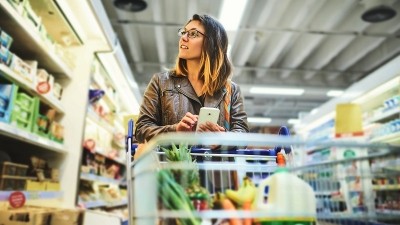Consumers shop digital channels more amid grocery price concerns, Ibotta reports

“This year’s State of Spend highlights the ongoing consumer struggle to overcome the compound effects of years of high grocery prices and stagnant shopper budgets, leading to growth in lower-cost private label brands. If shoppers take an exit ramp to a private label product, brands understand that the cost of inaction is steep. As they think strategically about how to win consumers back, digital promotions have proven to be one of the most cost effective and immediate solutions for growing market share,” Bryan Leach, founder and CEO of Ibotta, said in a press release.
Consumers feel more optimistic about the economy, but prices are still a concern
In its second annual State of Spend report, Ibotta surveyed more than 5,000 consumers and 400 CPG marketers to explore shifting shopping behaviors in response to economic concerns.
Consumers are feeling slightly better about the economy, with 21% of shoppers saying they have a good or excellent perception of the economy, up 1% from 2023, while 55% said they have a poor or fair perception of the economy, down 3% from 2023, according to Ibotta.
Shoppers are prioritizing food and beverage categories over personal care, pet care and other categories. The 2024 mean monthly spend was $280, up $12 from 2023 numbers, Ibotta found.
Additionally, Ibotta reports that more than two-thirds (70%) of consumers said that saving on groceries is important to them, which is down 5% from 2023. Many consumers (42%) said they are trying to save money to offset price increases, while 37% said they are saving on groceries because they need the savings to get by and 34% have a strict budget to follow.
Consumers shy away from new brands, amid slumping CPG innovation
Consumers are pushing back on what they deem as discretionary items at a time when CPG innovation has slowed.
When faced with a price increase, 19% of shoppers said that they would simply not purchase the item, while 51% said they would find a cheaper alternative.
Consumers are sticking to brands that they know, Ibotta reported. Most consumers (74%) said their grocery trips consist of brands and products they purchased in the past, and the remaining 26% came from new products.
Mintel found that 35% of global CPG launches in the first five months of 2024 were genuinely new products, which is the lowest rate of product innovation since Mintel began tracking innovation in 1996. The remaining 65% of launches were relaunches, line extensions, new packaging or reformulations.
Consumers turn to grocery delivery services more, as digital is a top way to save
Many shoppers are adjusting how frequently they head into the store to save time and money, marking a shift from how consumers responded to higher food prices. Amid high food inflation, consumers would typically frequent grocery stores more but purchase smaller baskets to better manage food price increases.
Now, almost half of shoppers (44%) used a grocery delivery service in the past month, up 3% from the previous year. Additionally, most consumers (77%) went into the grocery store at least once a week, down from 80% in 2023, and 23% said less than once a week, up from 20% in 2023.
This parallels data from market research company Circana that showed a widening gap between ecommerce and in-store sales. Ecommerce sales reached $145 billion for the year ending Aug. 18, growing 10.3% in units and 9.7% in dollars, compared to in-store sales, which declined 0.2% in dollars and 1.6% in units, according to Circana MULO data.
Most consumers (62%) utilize digital offers, while 55% of shoppers say they use in-store sales to save money, which is down 3% from 2023. Private-label products, loyalty cards and paper coupons rounded out the top five ways consumers saved money on groceries, with 42%, 38% and 28% of consumers, respectively, saying they use them.
Plant-based meat, dairy continue to see slumping demand
While often seen as categories resilient to challenging economic times, snacks and frozen foods are seeing slight dips in self-reported purchases. Three-fourths (75%) of consumers said they purchase snacks, and 68% said they are purchasing frozen foods, down from 79% and 71%, respectively from 2023 results.
Additionally, plant-based meat and dairy alternative products continue to decline in consumer acceptance and demand, as 16% of consumers said they purchased these products, down from 21% in 2023.
















